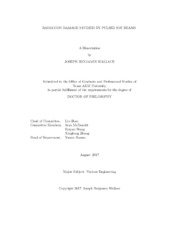| dc.description.abstract | Energetic particles propagating through crystalline materials can transfer their kinetic energy to target atoms in the form of knock-on collisions. These target atoms can then cause subsequent collisions with other target atoms, ultimately leading to the formation of a ballistic cascade of point defects. The formation and thermalization of ion cascades, which occurs at time scales up to ~ps, is thought to be reasonably well understood. However, the understanding of defect interaction after cascade thermalization, known as dynamic annealing, is quite limited, despite nearly five decades of research. Dynamic annealing often plays the dominant role in the formation of stable radiation disorder in crystalline solids. However, current models of radiation damage are essentially empirical fits to experimental data, incapable of capturing the full physics of the problem. Understanding dynamic annealing is crucial to describing radiation damage in crystalline solids of interest to electronics and nuclear materials applications. The purpose of this dissertation is to improve the understanding of dynamic annealing and radiation damage in crystalline materials.
To achieve this, a novel pulsed ion beam method was developed. A major difficulty in previous attempts to describe dynamic annealing was separating the spatial and temporal variables, which are convoluted in dose rate experiments. Such experiments often required overarching assumptions to isolate the defect lifetime and diffusion length. In contrast, the pulse beam method allows separation of the temporal and spatial aspects of dynamic annealing at the experimental level.
Using the pulsed beam method, a defect lifetime of ~ 0.1 − 100 ms and a characteristic diffusion length of ~ 5 − 50 nm are measured in Si, Ge, and SiC. In addition, the dynamic annealing rate shows an Arrhenius dependence in Si and Ge with activation energies in the range from _ 0.1 − 1.3 eV. Rate theory modeling, bench-marked against this data, suggests a crucial role of both vacancy and interstitial diffusion, with the dynamic annealing rate limited by the migration and interaction of vacancies. The defect lifetime, diffusion length, and dominant defect interaction mechanisms are sensitively affected by the bombarding ion mass, energy, target temperature, and pre-existing lattice defects.
These studies represent a significant advancement in the understanding of radiation defect dynamics in materials. Moreover, this dissertation lays the groundwork for future studies of radiation defect dynamics in other technologically relevant materials. | en |


